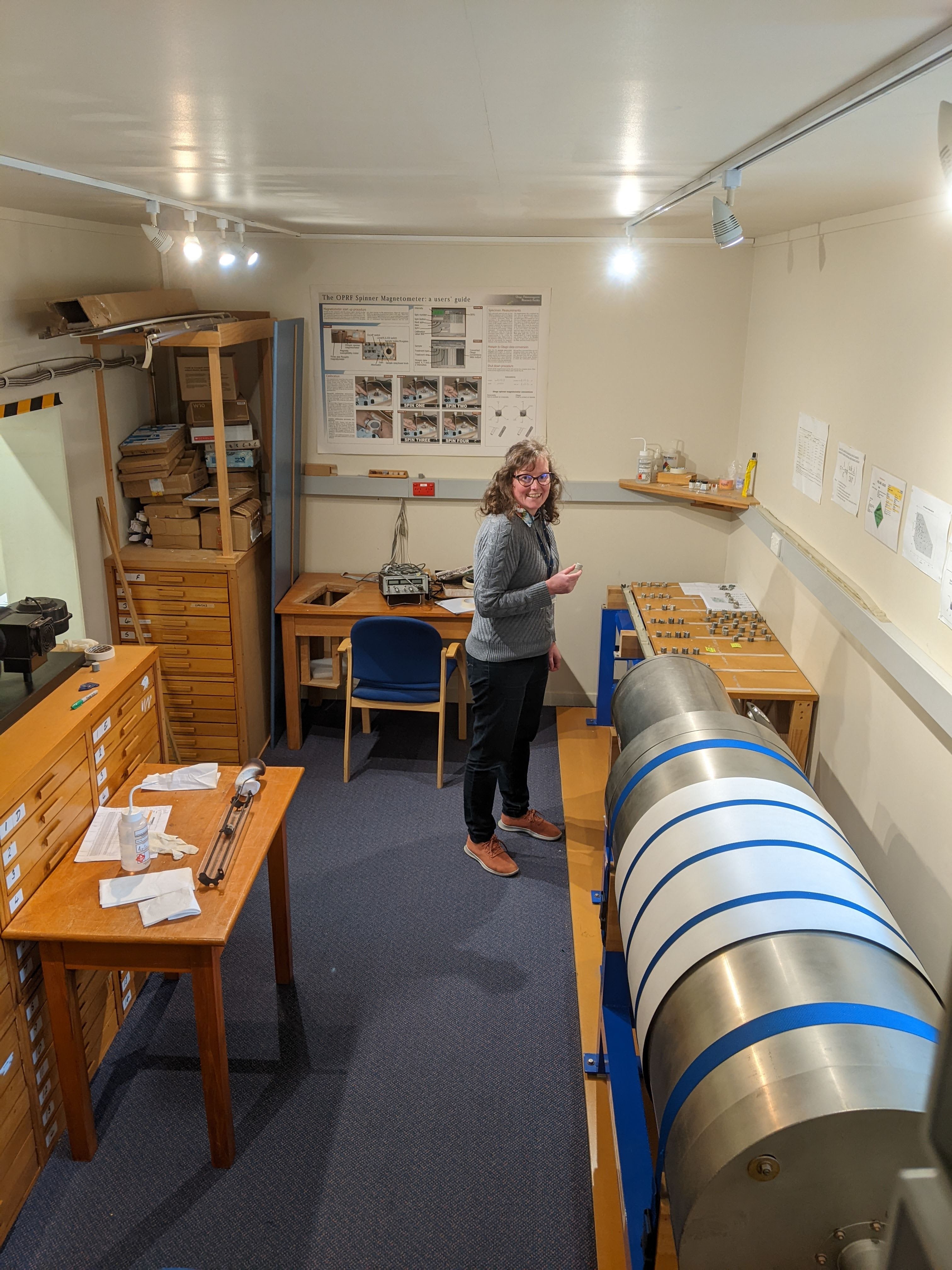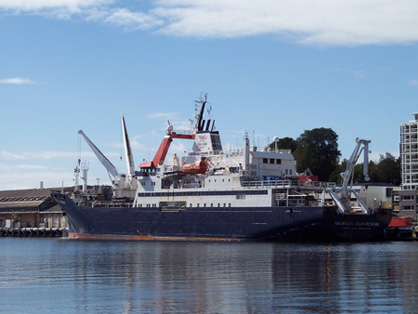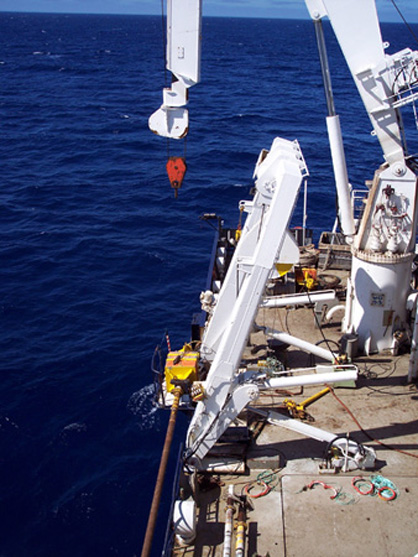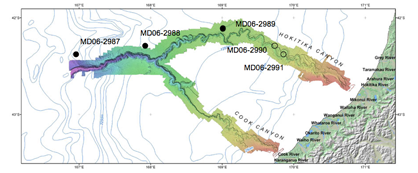
Paleomagnetist providing management, scientific direction, training and technical support for Otago Paleomagnetic Research Facility
Programme manager for Natural carbon sequestration in our southern fjords - a pathway towards carbon neutrality (MBIE Endeavour Project)
Email faye.nelson@otago.ac.nz
Google Scholar Faye E. Nelson
ORCID orcid.org/0000-0001-6241-0628
Current research
- Using environmental magnetic methods to investigate New Zealand vegetation as natural adsorbers and monitors of vehicle pollution
- Rocks for Tots: engaging young learners in participatory geoscience research (Curious Minds funded)
- Magnetostratigraphy, paleomagnetic paleothermometry, and other applications of rock magnetism in volcanology
- Paleomagnetism and environmental magnetism of marine piston cores from the south western coast of New Zealand, including Fiordland
- The geological record of Quaternary climate change and the application of paleomagnetic methods to dating and correlation and as proxies for environmental change
- Last Glacial Maximum (LGM) and deglacial signals in the marine record
- Hydrodynamic sorting of magnetic minerals; implications for current speed and near-shore paleobathymetry.
Magnetic grain-size; comparison of magnetic and other methods of determination, relationship between magnetic grain-size and mean sortable silt/whole sediment distribution
PhD research
New Zealand and its continental shelf are situated in a unique position to track changes in the global ocean and climate system. New Zealand spans the subtropical and subantarctic currents and intercepts and deflects both westerly winds and the westerly Antarctic Circumpolar Current (ACC). The ACC influences global ocean circulation and is considered to be a major climate driver. Furthermore, the New Zealand landmass presently contributes almost two percent of the global ocean sediment load per year. Rain and wind erosion (heightened by New Zealand's position as a barrier in the South Pacific) and tectonics (e.g., uplift caused by collision of the Pacific and Australian plates) contribute to New Zealand's high sedimentation rates. As a result, ocean sediment in the New Zealand sector of the South Pacific have the potential to record very high resolution records of both terrigenous and marine input that forms a globally relevant, Southern Hemisphere paleoclimate record.
Long sediment cores were collected from the banks of submarine Hokitika Canyon off New Zealand's West Coast during the MD152 MATACORE research cruise (Figures 1 & 2). Three cores (30-45m long) from the MATACORE cruise form a transect along Hokitika Canyon at various depths (1000->3000m) and record up to one million years of earth's geological and climatic history (Figure 3). In addition, shorter cores were collected during NIWA's West Coast Canyons II cruise. The paleomagnetic laboratory at Otago is equipped with a high-sensitivity, high-resolution cryogenic magnetometer suitable for long core samples. During the cruises, I assisted in collecting u-channel samples from the cores for a range of paleomagnetic and environmental magnetic analyses, including automated closely spaced measurements of natural remanent magnetism, alternating field demagnetisation, anhysteretic remanent magnetism and magnetic susceptibility. Remanent magnetism can provide a high-resolution (sub-millennial) chronology for the climate records through the determination of secular variation and paleointensity changes as well as the application of the more traditional magnetic polarity reversal stratigraphy.
Magnetic susceptibility (the magnetisability of a substance) can indicate changing types and concentrations of magnetic minerals, which in turn indicates the source of the minerals and/or the type of weathering the minerals underwent. Glacial conditions in the Southern Alps contributed non-oxidized, physically weathered minerals. Fieldwork in the Southern Alps aided in identifying the signatures of terrestrially-derived minerals in the cores.
New Zealand's offshore sediment record is an ideal matrix for environmental magnetic proxy indicators of paleoclimate. Magnetic properties of sediment cores can be used to better understand the dynamics of New Zealand's continental margin (e.g., catchment and canyon evolution through time) and its record of climate change. Hokitika Canyon provides an opportunity to understand the continuum of processes that affect paleomagnetism and environmental magnetism off New Zealand's South Island West Coast on sub-millennial timescales. Are Southern Alps events synchronous with Northern Hemisphere (N.H.) glaciations? Is there a hemispheric lead/lag in the onset or termination of glaciations? What is the role of insolation forcing?
 Figure 1: R/V Marion-Dufresne II about to embark on the MD 152/MATACORE "Tectonic and climatic controls on sediment budget" cruise (Hobart, Tasmania – Auckland, NZ) (January 24-February 6, 2006).
Figure 1: R/V Marion-Dufresne II about to embark on the MD 152/MATACORE "Tectonic and climatic controls on sediment budget" cruise (Hobart, Tasmania – Auckland, NZ) (January 24-February 6, 2006).
 Figure 2: Calypso piston coring system. The lead weight (up to 10 tonnes) drives the core pipe into marine sediment. The longest core recovered on this cruise was over 39 m long (MD06-2987).
Figure 2: Calypso piston coring system. The lead weight (up to 10 tonnes) drives the core pipe into marine sediment. The longest core recovered on this cruise was over 39 m long (MD06-2987).
Publications
Truax, O. J., Nelson, F., Riesselman, C. R., Ohneiser, C., Lee, J. I., Yoo, K.-C., Dagg, B., & Wilson, G. (2025). A Holocene paleosecular variation record from the northwestern Ross Sea, Antarctica. Geochemistry, Geophysics, Geosystems, 26, e2024GC011912. doi: 10.1029/2024GC011912 Journal - Research Article
Nelson, F., Jack, H., & Chanony, S. (Eds.). (2024). Geoscience Society of New Zealand Miscellaneous Publication: Mountains to Sea, 167A. Wellington, New Zealand: Geoscience Society of New Zealand. 279p. Retrieved from https://gsnz.org.nz Conference Contribution - Edited volume of conference proceedings
Reid, N.-J., Ohneiser, C., Gorman, A., Nelson, F., & Levy, R. (2024). Magnetic fabric analysis of laboratory deposited sediments to investigate paleo Antarctic Bottom Water velocity. In F. Nelson, H. Jack & S. Chanony (Eds.), Geoscience Society of New Zealand Miscellaneous Publication: Mountains to Sea. 167A, (pp. 210). Wellington, New Zealand: Geoscience Society of New Zealand. [Abstract] Conference Contribution - Published proceedings: Abstract
Nelson, F., Wilson, G., & Moy, C. (2024). Assessing Holocene secular variation and relative paleointensity from Tamatea Dusky Sound and Rakituma Preservation Inlet, Te Rua-o-te-moko Fiordland: Implications for paleomagnetism in carbon sink basins. In F. Nelson, H. Jack & S. Chanony (Eds.), Geoscience Society of New Zealand Miscellaneous Publication: Mountains to Sea. 167A, (pp. 181). Wellington, New Zealand: Geoscience Society of New Zealand. [Abstract] Conference Contribution - Published proceedings: Abstract
Nelson, F., Briggs, S., Stenning, A., & Palmer, M. (2024). Magnetic monitoring of particulate matter on leaves in Ōtepoti Dunedin: Participatory science with preschool and primary students. In F. Nelson, H. Jack & S. Chanony (Eds.), Geoscience Society of New Zealand Miscellaneous Publication: Mountains to Sea. 167A, (pp. 180). Wellington, New Zealand: Geoscience Society of New Zealand. [Abstract] Conference Contribution - Published proceedings: Abstract
